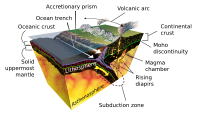
Photo from wikipedia
Processes linked to shallow subduction, slab rollback, and extension are recorded in the whole-rock major-, trace-element, and Sr, Nd, and Pb isotopic compositions of mafic magmatic rocks in both time… Click to show full abstract
Processes linked to shallow subduction, slab rollback, and extension are recorded in the whole-rock major-, trace-element, and Sr, Nd, and Pb isotopic compositions of mafic magmatic rocks in both time and space over southwestern United States. Eocene to Mio-Pliocene volcanic rocks were sampled along a transect across the west-central Great Basin (GB) in Nevada to the Ancestral Cascade Arc (ACA) in the northern Sierra Nevada, California (∼39°–40° latitude), which are interpreted to represent a critical segment of a magmatic sweep that occurred as a result of subduction from east-northeast convergence between the Farallon and North American plates and extension related to the change from a convergent to a transform margin along the western edge of North America. Mafic volcanic rocks from the study area can be spatially divided into three broad regions: GB (5–35 Ma), eastern ACA, and western ACA (2.5–16 Ma). The volcanic products are dominantly calc-alkalic but transition to alkalic toward the east. Great Basin lavas erupted far inland from the continental margin and have higher K, P, Ti, and La/Sm as well as lower (Sr/P)pmn, Th/Rb, and Ba/Nb compared to ACA lavas. Higher Pb isotopic values, combined with lower Ce/Ce* and high Th/Nb ratios in some ACA lavas, are interpreted to come from slab sediment. Mafic lavas from the GB and ACA have overlapping 87Sr/86Sr and 143Nd/144Nd values that are consistent with mantle wedge melts mixing with a subduction-modified lithospheric mantle source. Eastern and western ACA lavas largely overlap in age and elemental and isotopic composition, with the exception of a small subset of lavas from the westernmost ACA region; these lavas show lower 87Sr/86Sr at a given 143Nd/144Nd. Results show that although extension contributes to melting in some regions (e.g., selected lavas in the GB and Pyramid Lake), chemical signatures for most mafic melts are dominated by subduction-related mantle wedge and a lithospheric mantle component.
Journal Title: Geosphere
Year Published: 2020
Link to full text (if available)
Share on Social Media: Sign Up to like & get
recommendations!